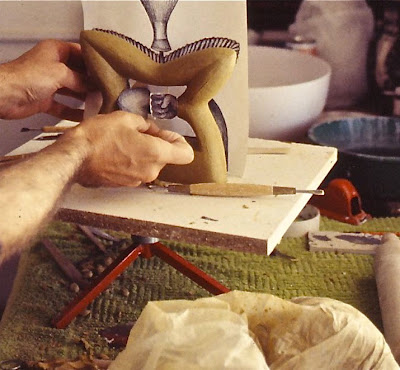 |
Inez van Lamsweerde/Art+ commerce / H&K
As cited in L'Officiel Hors-Serie McQueen. |
One of the most influential designers in my creative development has been Lee Alexander McQueen (follow link to his website). He passed away recently and I therefore thought it necessary to pay homage to this provocative genius - a truly remarkable fashion designer. This quote by the artist in 2002 provides the necessary connection between our creative thinking.
"I use things that people want to hide in their heads. War, religion, sex: things we all think about but don't bring to the forefront. But I do and I force them to watch it" text and image cited in Fashion Now, edited by Terry Jones and Avril Mair (2002:324).
 |
| ESHU Fall-Winter 2000 2001 |
 |
Portrait by Corinne Day
cited in FASHION NOW (page 32) |
He was born in London on March 17 in 1969. He left school at 16 and followed an apprenticeship as a tailor specializing in men's suits under Anderson & Sheppard and then Gieves & Hawkes. He completed his classical training at costumiers' Angles and Berman. He followed up his training working for Japanese Designer Koji Tatsuno and then assisted Romeo Gigli as a stylist. He finally graduated with a master in fashion design - his show was very spectacular; an enormous success ( the entire collection was purchased by Isabella Blow). It was this show, with the theme "Highland Rape" that inspired me greatly. Some of the hair styling was shaped like barbered wire, whilst the dresses were slit in rape-victim like fashion. The complimentary makeup was bloodied and bruised; at the time an integrated provocative approach to expressive couture. Visuals of this show is incredibly difficult to come by. The overall gestalt of the fashion statement is best described in the following quote by Matthew Callahan in his article titled "The ghosts that haunt us" follow link below.
"Disheveled hair, fake battle wounds, battered makeup effects, and ripped kilts all reflected the psychological processing and haunting of McQueen’s own ancestral past. Highland Rape furthermore acted as a way for McQueen to mimic and therefore expose structural inequality through a form of aesthetic resistance". Extract from an artcile written by Matthew Callahan, As cited at Zimbio.
 |
| Scanners Fall-Winter 2003-2004 |
What follows is a series of tributes and testimonies of fellow designers, celebrities and models as quoted in a special issue L'Officiel [De La Couture ET De La Mode De PARIS] titled Alexander McQueen 1969-2010. The quotes and testimonies are interspersed with my selection of images as cited in the above mentioned special issue. Obviously I have chosen images that best expresses his sculptural fashion statements.
"I admired him tremendously. He was a revolutionary. He will not be forgotten and it is an immense loss.(...) Daring, original, stimulating he understood how to be a fabulous ambassador for fashion" John Galliano.
.jpg) |
| Voss Spring-Summer 2001 |
'VISIONARY, HE WAS ALMOST A MEDIUM. UNCONSCIOUSLY PERHAPS, HE KNEW HOW TO FORSEE THE PRESENT CRISIS WITH HIS SHOW THAT WAS A TRIBUTE TO THE FILM THEY SHOOT HORSES , DON'T THEY? BY SYDNEY PLLACK. HE WAS A MAN MADE FOR STAGING WHO USED HIS DREAMS AND HIS NIGHTMARES. A FREE SPIRIT. AND AT THE SMAE TIME HIS SUITS ARE INCOMPARABLY PERFECT" VANNESA BELLUGEON.
.jpg) |
| Its Only a Game Spring-Summer 200%. |
"I am still in shock over his tragic loss. I am devastated. Lee McQueen was my dear friend" Kate Moss.
.jpg) |
| It's only a game Spring-Summer 2005 |
"He was one of the greatest fashion designers of his generation . Both a visionary and avant-garde. his creations were inspired by tradition and hyper modernity so that they were outside time." Francois Henri Pinault.
 |
| Sarabande Spring-Summer 2007 |
"We are deeply touched by the sudden death of Alexander McQueen, a designer that we have always admired for his creative genius and uncompromising inspiration. He has left an incomparable void in the world of fashion." Dolce and Gabbana.
"I AM INCREDIBLY SORRY." VIVIENNE WESTWOOD.
.jpg) |
| The Horn of Plenty Fall-Winter 2009 - 2010 |
"This death makes me very sad. (....) He had talent and was an artist. It makes me very sad." Piere Berge.
.jpg) |
| The Horn of Plenty Fall-Winter 2009 - 2010 |
'HE WAS VERY TALENTED AMD A VERY CREATIVE DESIGNER" PAUL SMITH.
.jpg) |
| The Horn of Plenty Fall-Winter 2009 - 2010 |
"HE WAS A UNCOMPROMISING CREATOR. A PROVOCATIVE GENIUS! IN ADDITION TO BEINNG A FABULOUS DIRECTOR. HE WAS TRULY A GREAT COUTURIER." MARIE -JOSE JALOU.
.jpg) |
| Plato's Atlantis Spring -Summer 2010. |
.jpg) |
| Plato's Atlantis Spring -Summer 2010. |
.jpg) |
| Plato's Atlantis Spring -Summer 2010. |
"McQueen was a master of fashion, a creative genius and an inspiration. Today, the fashion industry has lost someone of true value. An icon for all times. He made everything he touched beautiful and will be despairingly regretted. My heart is really with his family and his friends during this sad moment." Victoria Beckham.
 |
| The McQueensberry Rule, Fall-Winter 09 - 10 |











.jpg)
.jpg)
.jpg)


.jpg)
.jpg)
.jpg)
.jpg)
.jpg)
.jpg)




.jpg)


.jpg)

.jpg)


.jpg)


.jpg)
.jpg)





.JPG)







